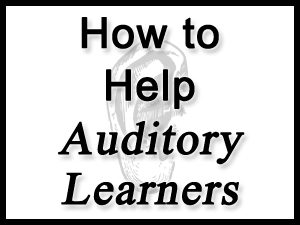
Auditory learners are a chatty bunch. They love to socialize and enjoy listening to music.
As I explained in the first post in this series on Visual Auditory Kinesthetic Learning Styles, it’s a good idea to understand each of your child’s learning styles. That information can help you to teach them more easily and effectively because you can modify the curriculum to work well with each child’s brain.
Auditory learners have their own unique traits and styles of learning. I’m going to share with you the characteristics which make them who they are as well as methods you can use to instruct them. It is my hope that this information will help you to succeed in teaching your auditory learner.
Characteristics of Auditory Learners
Below you’ll find a list of characteristics that an auditory learner can have. Not all of these traits will be true for all auditory learners. If you find that the majority of them are true for one of your children, then the auditory learning style is likely his dominant modality.
Auditory learners:
- enjoy talking
- like to listen to music
- hum or sing to themselves
- think in words or hear words in their heads
- like to be read to
- ask lots of questions
- can be more social
- talk to themselves sometimes
- like to read aloud
- are good at explaining things verbally
- work well in groups
- prefer lectures and discussions
- seldom write things down
- don’t like to take notes
- sometimes repeat what was said
- can recognize the tone of voice, speed and pitch at which someone speaks and use it to interpret meaning
- sometimes struggle with tasks that require reading and writing
- are good speakers
- lose concentration easily
- are distracted by noises
- remember names but not faces
- tend to be outgoing
- can have poor handwriting skills
- like theater and other performing arts
Tips for Helping Auditory Learners
Here are some techniques you can use to help an auditory learner succeed.
- Let your child listen to music while studying
- Give directions verbally
- Use phonics to teach your child to read
- Teach your child to sound out words and enunciate the syllables to help him read, write, and spell
- Use recitation
- Explain concepts orally
- Engage your child in discussions
- Let your child work in small groups
- Use word associations, analogies, and storytelling to help your child learn facts
- Let your child repeat things aloud to solidify learning
- Use rhymes, chants, and songs to help your child memorize and learn
- Encourage your child to ask questions
- Let your child work out problems by thinking aloud
- Use videos or recorded lectures
- Play audio books
- Read aloud to your child
- Let your child participate in some kind of performing arts such as choir, band, drama, or Reader’s Theater
If you have children who prefer a silent learning environment along with an auditory learner, you may want to let the auditory learner work in a separate room so that he can talk aloud without disturbing anyone.
If handwriting and other copywork are a challenge for your auditory learner, you may want to use products like Homeschooling with a Touch of Class copywork which incorporates classical music with writing.
Some helpful items to have on hand with an auditory learner include:
- a recording device like a computer, iPad, tablet, or cell phone
- music for your child to listen to
- audio books
- an mp3 player or iPod
To learn more about the other Visual Auditory Kinesthetic learning styles, click on the links below.






